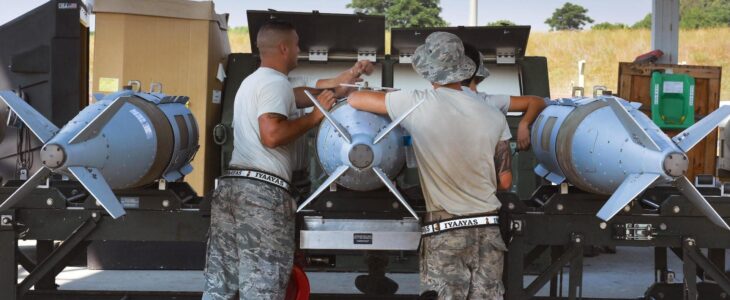
Russian jamming has become so effective that Ukraine — as well as the US and NATO — can no longer assume that Joint Direct Attack Munition glide bombs and other smart weapons will hit their targets.
That’s the conclusion of an analysis by Britain’s Royal United Services Institute. “Jamming is not causing the JDAMs to stop working, but it is risking their accuracy,” according to RUSI researcher Thomas Withington.

While anti-jamming upgrades to JDAM may mitigate the problem, Russian electronic-warfare systems can simply drown out the GPS guidance signal from satellites. “The problem may well be the sheer power of the jamming signal that can be brought to bear,” Withington said.
The warning comes after Pentagon documents leaked in April revealed concerns that Russian jamming was reducing the accuracy of American guided weapons, including JDAM as well as HIMARS rockets.


Ukrainian troops fire M142 HIMARS rockets toward Bakhmut in May.Serhii Mykhalchuk/Global Images Ukraine via Getty Images
The effect on JDAM is particularly significant, as it is arguably the simplest and most cost-effective smart bomb. By attaching fins and a GPS guidance system to cheap, old-fashioned “dumb” bombs, Ukraine could produce long-range guided weapons at a fraction of the cost of special precision-guided munitions that are in short supply.
The JDAM Extended Range bombs sent to Ukraine reportedly have a range of up to 50 miles, allowing launch aircraft to remain safely out of range of Russian air defenses.
These GPS-guided munitions initially offered Ukraine hope of offsetting Russian superiority in manpower and weapons. Indeed, HIMARS proved crucial in Ukraine’s limited counteroffensive in summer 2022, as rockets devastated Russian headquarters and supply dumps.
That Russia is developing countermeasures shouldn’t be surprising. All weapons eventually lose some effectiveness as the enemy adapts. Nor is it a secret that the Russian military, like its Soviet predecessor, devoted great effort to developing a variety of electronic-warfare systems.
In particular, Withington pointed to the Russian Army’s R-330Zh Zhitel, a mobile truck-mounted jamming system specifically designed to disrupt GPS and satellite communications in the 100 MHz to 2 GHz wavebands. “Signals from the U.S. GPS satellites which JDAM kits use are transmitted on wavebands from 1.164 GHz to 1.575 GHz,” according to Worthington. “These fall squarely within the R-330Zh’s catchment area.”

A Russian R-330Zh Zhitel electronic-warfare jamming station in July 2018.Denis Abramov/Russian Defense Ministry via Mil.ru
Worthington claims to have seen official documents that put the R-330Zh range at 18.6 miles, with a 10kW-strong jamming signal. This is “notably stronger than the strength of the GPS signal arriving from space,” he noted. “Moreover, the closer the GPS receiver is to the R-330Zh’s jamming antenna, the stronger the jamming signal becomes.”
In theory, the Selective Availability Anti-Spoofing Module upgrade to JDAM in the early 2000s should ensure that JDAM will only respond to authorized M-Code encrypted military GPS signals. However, Russian jammers may still be able to disrupt the signals through “sheer brute force” jamming beams, Withington said.
Russia could also intercept M-Code signals and retransmit them with slight alterations to a JDAM, causing the bomb to miss. Efforts to bypassing Russian interference by using signals from multiple GPS satellites could in turn be countered by employing multiple jammers.
Russia’s counter-GPS efforts are part of a massive electronic-warfare campaign that has also disrupted Ukrainian radio communications and drone operations.
Russian forces “now employ approximately one major EW system per 10 kilometers [6.2 miles] of frontage, usually situated approximately 7 kilometers [4.3 miles] from the frontline,” according a recent RUSI report on Russian tactics. This jamming has contributed to a Ukrainian drone loss rate that RUSI estimates to be as high as 10,000 UAVs per month.

A Ukrainian army officer uses a radio at a frontline position in Kharkiv Oblast in May 2022.John Moore/Getty Images
According to the RUSI report, Russian EW troops are also “highly capable” at intercepting and decrypting Ukrainian radio communications. In one case, they appeared to intercept and decode an encrypted radio message from Ukrainian troops calling in a fire mission in real time, allowing Russian commanders to send “pre-emptive warning” to their units.
Nonetheless, Russian electronic warfare has limitations. Emitting jamming beams discloses a jammer’s location, and Ukraine appears to have located and destroyed Russian systems such as the R-330Zh. Ironically, smothering the airwaves with powerful jamming beams may also be disrupting Russian GPS and radio communications.
“Russia’s GLONASS GNSS constellation transmits some signals which are similar to GPS,” Withington noted. There is evidence that “the Russian Army regularly suffers electromagnetic fratricide to this end. The force often exhibits scant concern for jamming friendly signals when attacking its enemies.”
Jamming hasn’t made JDAM obsolete. Like other facets of warfare, electronic warfare is like a chess game, where move is followed by countermove. Either way, US engineers “may have to rethink how they safeguard JDAMs for the wars of tomorrow, based on the conflicts of today,” said Withington.
Credit: Yahoo News
